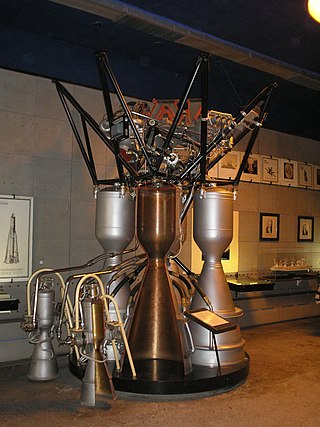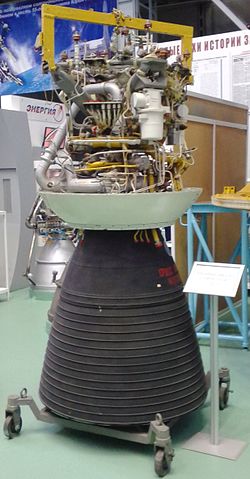
Energia was a 1980s super-heavy lift launch vehicle. It was designed by NPO Energia of the Soviet Union as part of the Buran program for a variety of payloads including the Buran spacecraft. Control system main developer enterprise was the Khartron NPO "Electropribor". The Energia used four strap-on boosters each powered by a four-chamber RD-170 engine burning kerosene/LOX, and a central core stage with four single-chamber RD-0120 (11D122) engines fueled by liquid hydrogen/LOX.

The RD-170 is the world's most powerful and heaviest liquid-fuel rocket engine. It was designed and produced in the Soviet Union by NPO Energomash for use with the Energia launch vehicle. The engine burns kerosene fuel and LOX oxidizer in four combustion chambers, all supplied by one single-shaft, single-turbine turbopump rated at 170 MW (230,000 hp) in a staged combustion cycle.

Blok D is an upper stage used on Soviet and later Russian expendable launch systems, including the N1, Proton-K and Zenit.

The RD-107 and its sibling, the RD-108, are a type of rocket engine used on the R-7 rocket family. RD-107 engines are used in each booster and the RD-108 is used in the central core. The engines have four main combustion chambers and either two (RD-107) or four (RD-108) vernier chambers.

The RD-253 (Russian: Ракетный Двигатель-253 (РД-253), romanized: Raketnyy Dvigatel-253, lit. 'Rocket Engine-253') and its later variants, the RD-275 and RD-275M, are liquid-propellant rocket engines developed in the Soviet Union by Energomash. The engines are used on the first stage of the Proton launch vehicle and use an oxidizer-rich staged combustion cycle to power the turbopumps. The engine burns UDMH/N2O4, which are highly toxic but hypergolic and storable at room temperature, simplifying the engine's design.
The RD-120 is a liquid upper stage rocket engine burning RG-1 and LOX in an oxidizer rich staged combustion cycle with an O/F ratio of 2.6. It is used in the second stage of the Zenit family of launch vehicles. It has a single, fixed combustion chamber and thus on the Zenit it is paired with the RD-8 vernier engine. The engine was developed from 1976 to 1985 by NPO Energomash with V.P. Radovsky leading the development. It is manufactured by, among others, Yuzhmash in Ukraine.
The Blok DM-03, GRAU index 11S861-03, is a Russian upper stage used as an optional fourth stage on the Proton-M and Angara A5 heavy-lift rockets. Three have been launched, the first in December 2010; the first two launches failed before fourth stage ignition, the first as a result of a problem with the Blok DM's fuel load. Some versions are also known as Orion.

The S1.5400 was a Soviet single-nozzle liquid-propellant rocket engine burning liquid oxygen and kerosene in an oxidizer-rich staged combustion cycle, being the first rocket engine to use this cycle in the world. It was designed by V. M. Melnikov, an alumnus of Isaev, within Korolev's Bureau, for the Molniya fourth stage, the Block-L. It was also the first Soviet engine designed for start and restart in vacuum and had the highest Isp at the time of its deployment.

The RD-0210 (GRAU Index: 8D411K) is also known as the RD-465. It and its twin, the RD-0211, are rocket engines burning N2O4 and UDMH in an oxidizer rich staged combustion cycle. They have single nozzle, possess TVC and are the latest evolution in the RD-0203/4 lineage. They are the engines used on the Proton second stage. The RD-0213 is a fixed nozzle variation that is used on the RD-0212 module of the Proton third stage.
The RD-0216 and RD-0217 are liquid rocket engines, burning N2O4 and UDMH in the oxidizer rich staged combustion cycle. The only difference between the RD-0216 and the RD-0217 is that the latter doesn't have a heat exchanger to heat the pressuring gasses for the tanks. Three RD-0216 and one RD-0217 were used on the first stage of the UR-100 ICBM. The engines were manufactured until 1974 and stayed in operational use until 1991. More than 1100 engines were produced.
The RD-0237 (GRAU Index 15D114) is a pressure-fed liquid rocket vernier engine, burning N2O4 and UDMH. It is used on the UR-100UTTKh MIRV vehicle to supply thrust vector control by gimbaling of its nozzle. While the engine is out of production, the ICBM and Strela remain operational as of 2015.
The RD-263 (GRAU Index 15D117) is a liquid rocket engine, burning N2O4 and UDMH in the oxidizer rich staged combustion cycle. Four RD-263 engines form a propulsion module RD-264 (GRAU Index 15D119). For the R-36M KB Yuzhnoye only ordered the first stage propulsion to Energomash, instead of both stages, arguing that they were overworked with the RD-270 development. By April 1970 Yuzhnoye was getting the engine documentation. By the end of 1972 Energomash started to test fire the engines in its own test stand. And by September 1973 the engine was certified for flight. While the engine is out of production, the ICBM as well as the Dnepr remain operational as of 2015.

The RD-119 was a liquid rocket engine, burning liquid oxygen and UDMH in the gas-generator cycle. It has a huge expansion ratio on the nozzle and uses a unique propellant combination to achieve an extremely high isp of 352 s for a semi-cryogenic gas-generator engine. It also has a unique steering mechanism. The engine main nozzle is fixed, and the output of the gas generator is fed into four nozzles on the side of the engine. Instead of using gimbaled verniers to supply vector control, the combustion gases are distributed by an electrically driven system that can control the thrust among the nozzles.

The RD-214 (GRAU Index 8D59) was a liquid rocket engine, burning AK-27I (a mixture of 73% nitric acid and 27% N2O4 + iodine passivant and TM-185 (a kerosene and gasoline mix) in the gas generator cycle. As was the case with many V-2 influenced engines, the single turbine was driven by steam generated by catalytic decomposition of hydrogen peroxide. It also had four combustion chambers and vector control was achieved by refractory vanes protruding into the nozzle's exhaust.
The KTDU-35 was a Soviet spacecraft propulsion system composed of two liquid rocket engines, the primary, S5.60 (SKD) and the secondary S5.35 (DKD), fed from the same propellant tanks. Both engines burn UDMH and AK27I in the gas generator cycle. It was designed by OKB-2, the famous Isaev Design Bureau, for the original Soyuz programme.
The 11D428A-16 (manufacturer's name RDMT-135M) is a liquid pressure-fed rocket engine burning N2O4/UDMH with an O/F of 1.85. It is used for crew-rated spacecraft propulsion applications. It is currently used in the KTDU-80 spacecraft propulsion module. The previous version, the 11D428A (manufacturer's name RDMT-135) is still used as the reaction control system thrusters of the Zvezda ISS module. The 11D428A-16 generates 129.16 N (29.04 lbf) of thrust with a chamber pressure of 0.88 MPa (128 psi) and achieves a specific impulse of 291 s (2.85 km/s). It is rated for 500,000 starts with a certified ignition time of 0.03 seconds to 2000 seconds. Each unit weights 1.5 kg (3.3 lb).

The RD-250 (GRAU Index 8D518) is the base version of a dual-nozzle family of liquid rocket engines, burning N2O4 and UDMH in the gas-generator open cycle. The RD-250 was developed by OKB-456 for Yangel's PA Yuzhmash ICBM, the R-36 (8K67). Its variations were also used on the Tsyklon-2 and Tsyklon-3 launch vehicles. It was supposed to be used on the Tsyklon-4, but since the cancellation of the project it should be considered as out of production.

The RD-215 (GRAU Index 8D513) was a dual nozzle liquid rocket engine, burning AK-27 (a mixture of 73% nitric acid and 27% N2O4 + iodine passivant) and UDMH. It was used in a module of two engines (four nozzles) known as the RD-216 (GRAU Index 8D514). The RD-215 was developed by OKB-456 for Yangel's Yuzhmash R-14 (8K65) ballistic missile. Its variations were also used on the Kosmos-1, Kosmos-3 and Kosmos-3M launch vehicles.
The RD-861 is a Soviet liquid propellant rocket engine burning UDMH and nitrogen tetroxide in a gas generator combustion cycle. It has a main combustion chamber, with four vernier nozzles fed by the gas generator output. It can be reignited a single time.
The RD-864 is a Soviet liquid propellant rocket engine burning UDMH and nitrogen tetroxide in a gas generator combustion cycle. It has a four combustion chambers that provide thrust vector control by gimbaling each nozzle in a single axis ±55°. It is used on the third stage of the R-36M UTTKh and Dnepr. For the R-36M2, an improved version, the RD-869 was developed. The MEA is an evolution of the RD-869 used on the Vega C.













